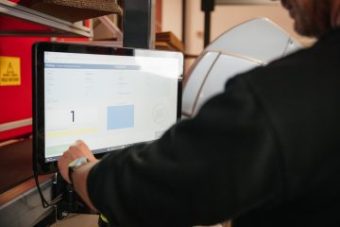How to choose the right warehouse software
Warehouse automation software is an integrated program used to automate warehouse operations and manual tasks. Selecting the right software for your warehouse is crucial to its success.

Choosing the right warehouse software can be challenging and you might not know where to start. Software and data utilization can improve warehouse efficiency and accuracy. However, to realize the full potential of warehouse automation it is important to invest in software that solves your challenges, increases your revenue, and optimizes your warehouse performance.
Warehouse automation has come a long way from its humble beginnings in 1913 when Henry Ford introduced the moving assembly line, an early solution for material flow handling automation. Modern solutions are more complex, and software plays an important role in managing the warehouse automation flow.
Some of the most common software applications found in modern warehouses:
- Enterprise Resource Planning (ERP)
- Warehouse Management System (WMS)
- Warehouse Control System (WCS)
- Transportation Management System (TMS)
- Order Management System (OMS)
- Barcode scanning and labeling Software
- Demand Forecasting and Planning Software
- Labor Management System (LMS)
- Material Flow Handling System
- Robotics Software
Businesses can gain significant financial and practical advantages by consolidating multiple functionalities into one software platform, enabling streamlined operations and enhanced efficiency.
Checklist for choosing the right warehouse software
To fully capitalize on the benefits of warehouse automation solutions, it’s important to pair them with the right software. With several options available, here are the key features to look for:
- Is it easy to use?
User-friendly, intuitive, and accessibility are important features to look for in warehouse automation software.
This is achieved when the software developers work closely with the actual users and understand the “pains” as well as incorporating user feedback during the development process. The software should be “plug-and-play” and not require a user manual for day-to-day use. - Is it standardized with scalability available?
Software solutions must be standardized to be useful and affordable for a wide range of customers.
However, if you require custom functionality, the software provider must be able provide it in a way that can be useful to the rest of the specific customer segment. - Can you grow with it?
If you choose software with modular elements, you will be able to pick and choose the modules and functionalities you need. This results in a solution that reflects your needs in the best way, without having to pay for unused functionality. - Can it communicate with existing software?
To get a fully interconnected warehouse solution, the software needs to be able to easily integrate with existing systems. This allows you to operate your entire hardware fleet from a central software system with one interface for all tasks, saving you time and resources. - Is it based on modern technology?
To ensure manageable maintenance and further development, the software technology should be based on leading-edge technology. The ability to easily integrate with new technology to secure continuous value for customers is also crucial. - Does it provide insights?
The software needs to feed itself and the users with valuable insights. Intelligent software will tell warehouse workers which tasks they should prioritize, while also leveraging data to develop new ways to increase warehouse automation.
Using these functionalities as guidance when choosing warehouse automation software enables you to build your warehouse for the future.
Element Logic offers a software ecosystem made to empower your warehouse by minimizing your pains and maximizing your performance. Our new software eLogiq is a cloud-based data platform that collects, analyzes, shares, and utilizes data streams from various data sources in real-time.
For more information about warehouse automation software, we recommend that you read our whitepaper about data utilization: The next level of warehouse automation.
Our experts are always ready for your questions and can help you clarify what warehouse automation software your company can benefit from.



